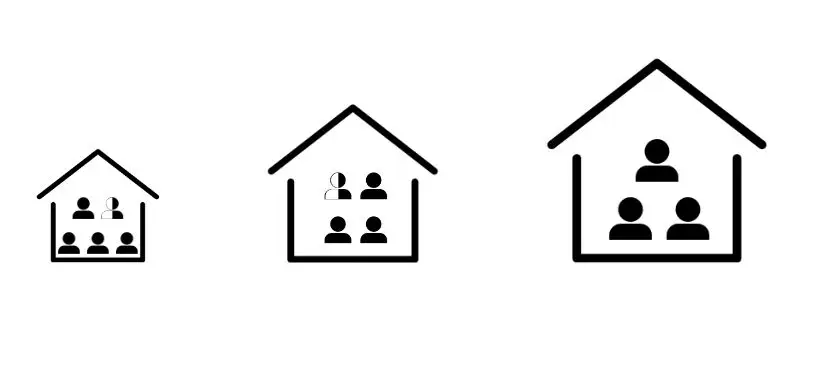
As housing prices continue to climb and competition for affordable, well-situated homes intensifies, it’s no surprise that people are exploring alternative solutions. Additionally, many are rethinking how they can foster connection and a sense of belonging in the places they call home. This is where co-living comes into play.
In simple terms, co-living involves a group of individuals sharing a living space. Each property typically includes a mix of private and communal areas. Residents usually have their own bedroom, studio, or apartment, while shared facilities like kitchens, living rooms, gardens, and sometimes gyms or event spaces, are available to everyone in the community.
Most co-living environments are thoughtfully designed to prioritize social interaction, creating shared areas that encourage connection. Many also organize regular events, offering residents opportunities to explore new activities and meet like-minded individuals.
This concept has been a staple for years in settings such as student housing, traveler and backpacker accommodations, and even for workers living on cruise ships or in large off-site barracks.

If there’s one thing COVID-19 has highlighted, it’s how much we value meaningful social connections. Research shows that without these supportive bonds, feelings of loneliness and stress can significantly increase.
For those living alone or in city outskirts with limited access to social networks or opportunities for interaction, alternative living arrangements provide a chance to be part of a community.
Housemates and neighbors have the potential to become more than acquaintances – they can be friends, family, coworkers, and part of your community. These are people you can lean on, have conversations with, and in the best cases, develop lasting and genuine friendships.
Pro: Community
It’s well known that connection and a sense of belonging are crucial for mental and emotional health. Co-living spaces are intentionally designed to foster interactions, share responsibilities, and encourage collaboration, allowing residents to feel integrated into a supportive community.
Con: Limited Privacy in Some Cases
Sharing close quarters with others can sometimes impact privacy. While most residents have private rooms, studios, or apartments, the communal aspect of co-living means frequent interaction in shared spaces, which may not suit everyone.
Pro: Added Value for Your Money
Although co-living isn’t always cheaper than renting, it often offers much more for the cost. Many co-living spaces include amenities such as gyms, organized events, communal gardens, and other perks, providing excellent value.
Con: Limited Personalization
While some co-living spaces allow for customization, many come fully furnished, leaving limited room for residents to add their personal touch. Those who value decorating or furnishing their own living space may find this restrictive.
Pro: Flexible Living Arrangements
For individuals transitioning between jobs or cities, co-living can provide a flexible housing option. Many spaces offer short-term leases, such as six months or one year. However, for those who value consistency, the frequent turnover of residents might feel unsettling.
Con: Potential Overcrowding
A survey by One Shared House 2030 revealed that most people prefer shared living arrangements with fewer than 10 residents. However, many large co-living spaces house significantly more people, which can feel overwhelming for those who enjoy smaller social groups.

Co-living is a modern housing concept that blends private accommodations with shared communal areas, and it’s quickly gaining traction worldwide. This approach appeals especially to young professionals and individuals seeking a sense of belonging, as it nurtures social connections while remaining budget-friendly. Designed for contemporary urban lifestyles, co-living has thrived in major cities like New York, London, and Shanghai.
In Melbourne, where housing affordability is an increasing concern, co-living offers a potential solution to balance the high cost of living with the desire for community. By encouraging social interactions in shared spaces and keeping expenses manageable, co-living provides an attractive option for many urban residents.
As the co-living trend continues to expand in Melbourne, the appeal of affordable options—whether in housing or entertainment—remains in tune with the needs of modern city life.

August 9, 2023

August 9, 2023

September 20, 2023

August 21, 2024
All contents published on this website or otherwise made available by TPG Property Group Pty Ltd to you is general information only and is intended to help you in understanding the products and services offered by TPG Property Group Pty Ltd. The information does not take into considerations of any particular investment objectives or financial situation of any potential reader. It does not constitute, and should not be relied on as, financial, investment, legal or any other professional advice or recommendations both expressed or implied. It should not be used as an invitation to take up any investments or investment services. You are advised to do your own due diligence when it comes to making financial and investment decisions and should use caution and seek the advice of qualified professionals such as accountant, lawyer, or other professional advisors before acting on this or any information. TPG Property Group Pty Ltd, its employees or contractors do not represent or guarantee that the information is accurate or free from errors or omissions and therefore provide no warranties or guarantees. You may not consider any examples, documents, or other content on the website or otherwise provided by us to be the equivalent of professional advice. Nothing contained on the website or in materials available for download on the website provides professional advice in any way. TPG Property Group Pty Ltd disclaims any and all duty of care and liability and assumes no responsibility for and you will indemnify TPG Property Group Pty Ltd against any losses or damages resulting from your use of any link, information, or opportunity contained within the website or any information within it.